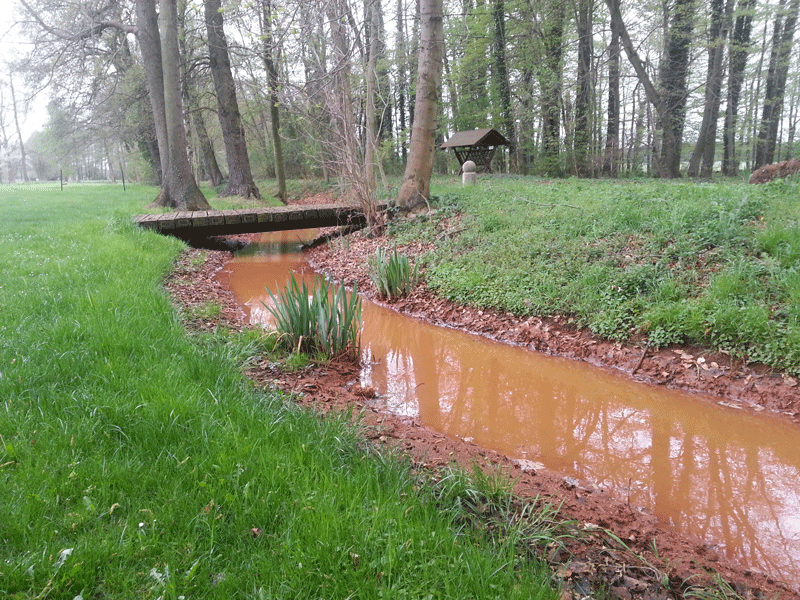Peatlands reduce mine pollutants
Peat soil laid over chalk rock, with a layer of clay in between, can reduce iron and sulphate contamination of mine water by more than 80%, according to researchers in Germany.

Lignite mining excavates material that contains pyrite, which reacts with oxygen and water to make sulphuric acid and dissolved iron. The sulphate and iron compounds and acidic pH make the mine drainage a pollutant for water bodies.
Landscapes such as those that have been mined in Lusatia, Germany, have a high amount of acid-mine drainage. Rivers, lakes and aquifers have resulting high levels of iron and sulphate.
To investigate the potential of peatland rewetting to treat the water, teams from The Humboldt University of Berlin and the Leibniz-Institute of Freshwater Ecology and Inland Fisheries (IGB) made a lysimeter experiment with acid-mine drain water and organic soil.
Polluted water came from a groundwater monitoring site and peat cores were taken from a drained peatland in the Lusatia lignite mining district in East Germany. After adding 3.8l of polluted groundwater to different plastic tubes filled with peat, the water percolated through soil columns for three to seven months. Different hydraulic loads or water residence time were simulated to correspond with the differing pollutant loads. The lower the hydraulic or material load, the more sulphate is removed, and the higher the hydraulic load, the shorter contact time of mine water with peat substrate.
Initial concentrations of iron at 250mg/l and sulphate at 770mg/l fell 87% and 78%, respectively.
The researchers admit that the temperature of the peat sample at 24°C might match soil temperatures in the summertime at the surface but might be 10°C less with increasing soil depth. The pH of the sampled peatland increases from four to six, and the electrical conductivity – an indicator of water quality – decreases by up to 47%.
Guest scientist at IGB, Dominik Zak, adds, ‘In our scenario calculation, we considered the rewetting of all drained peatland sites of the sub-catchment under investigation which correspond to catchment/wetland ratio of about 15. At this ratio, we can expect that most iron would be retained, and the water would be almost neutralised.’
For the heavily polluted section of the River Spree, the researchers estimate that rewetting the sub-catchment area of peatland could reduce the sulphate load by about 20% or 36,827t/y. The peatlands are 6,067ha or 6.7% of the total area of the sub-catchment.
Zak suggests that constructed wetlands might therefore be a suitable mitigation measure post-mining, for example, at the outlet of acid mining lakes after coal mining has ceased.
He adds, ‘There are [also] several investigations from non-lignite mining areas showing that rewetting of peatlands is a highly cost-efficient measure to mitigate the pollution of surface waters, for example from agricultural non-point pollution.’
Moving forward, Zak notes that the nature of pollutant degradation in decomposed peat layers needs to be determined – i.e. is it due to acidification or lack of bioavailable carbon? – alongside the long-term effects of rewetting peatlands with acid-mine drainage.
The biogeochemical processes of peatlands are influenced by temperature fluctuations and hydrological changes over a year, as well as small-scale differences in physical and chemical soil.
As peatlands are transition and buffer zones between terrestrial and aquatic ecosystems, they are sinks for carbon, phosphorous and nitrogen. Along with water storage, they are termed ‘kidneys in the landscape’, and if they dry out, they can release nutrients and greenhouse gases in return.
Zak explains, ‘At the one hand, substances like sulphate can be taken up directly, [on the other hand] the release of organic acids via the root system might mediate microbial processes in the soil. That’s why laboratory results should be always transferred to the field scale with high caution.
‘The next step must be to conduct a rewetting experiment under field conditions which needs comprehensive instrumentation and sampling effort to gain a solid data basis on the water and nutrient balance.’

